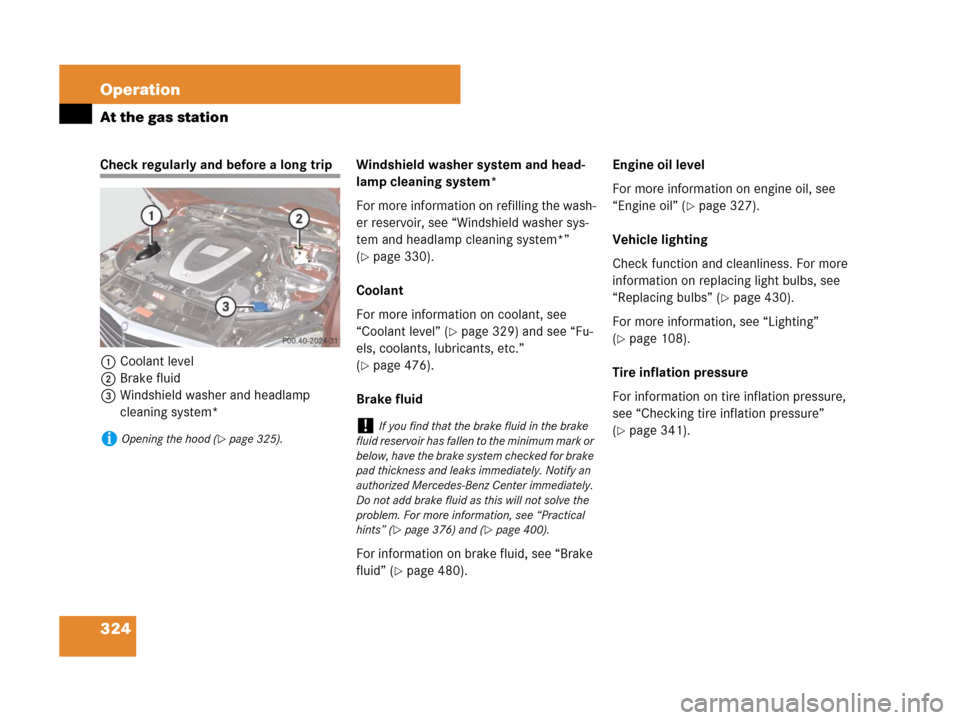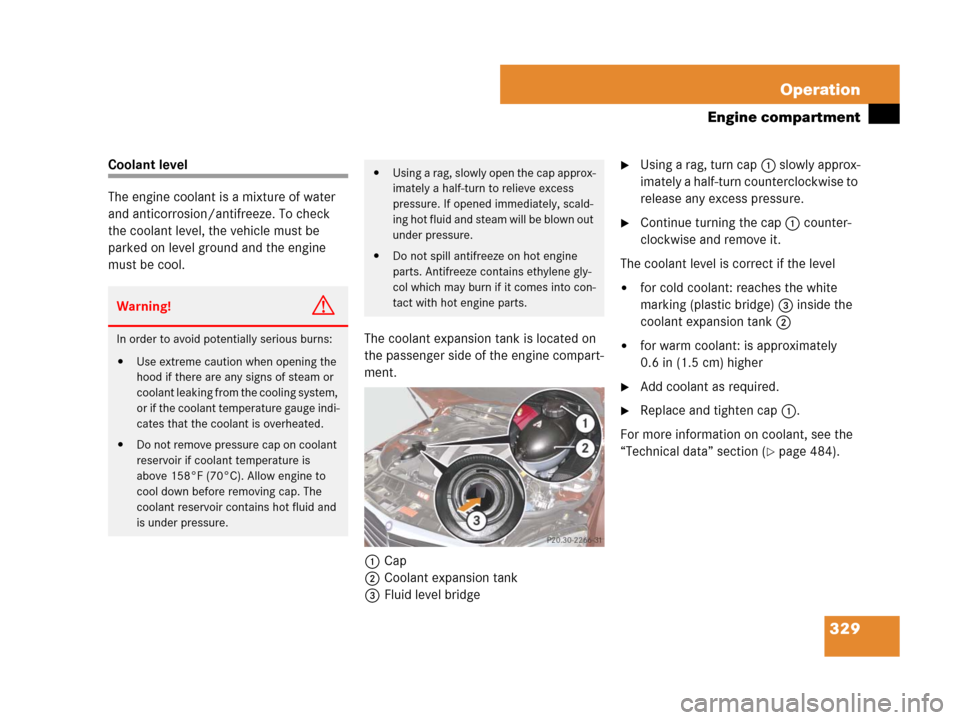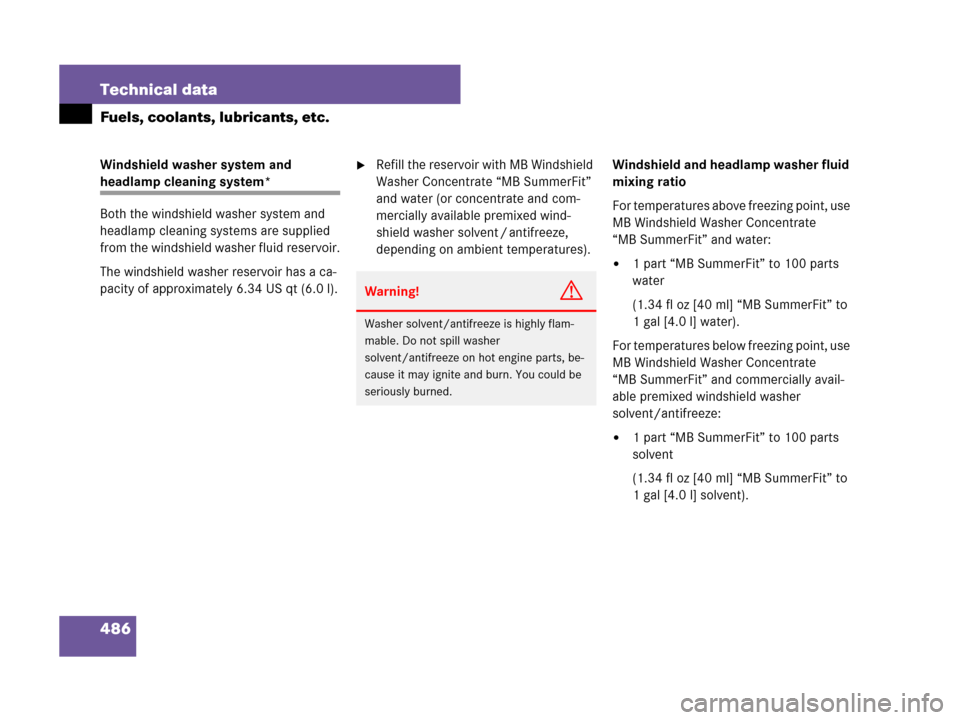Page 325 of 509

324 Operation
At the gas station
Check regularly and before a long trip
1Coolant level
2Brake fluid
3Windshield washer and headlamp
cleaning system*Windshield washer system and head-
lamp cleaning system*
For more information on refilling the wash-
er reservoir, see “Windshield washer sys-
tem and headlamp cleaning system*”
(
�page 330).
Coolant
For more information on coolant, see
“Coolant level” (
�page 329) and see “Fu-
els, coolants, lubricants, etc.”
(
�page 476).
Brake fluid
For information on brake fluid, see “Brake
fluid” (
�page 480).Engine oil level
For more information on engine oil, see
“Engine oil” (
�page 327).
Vehicle lighting
Check function and cleanliness. For more
information on replacing light bulbs, see
“Replacing bulbs” (
�page 430).
For more information, see “Lighting”
(
�page 108).
Tire inflation pressure
For information on tire inflation pressure,
see “Checking tire inflation pressure”
(
�page 341).iOpening the hood (�page 325).!If you find that the brake fluid in the brake
fluid reservoir has fallen to the minimum mark or
below, have the brake system checked for brake
pad thickness and leaks immediately. Notify an
authorized Mercedes-Benz Center immediately.
Do not add brake fluid as this will not solve the
problem. For more information, see “Practical
hints” (
�page 376) and (�page 400).
Page 330 of 509

329 Operation
Engine compartment
Coolant level
The engine coolant is a mixture of water
and anticorrosion/antifreeze. To check
the coolant level, the vehicle must be
parked on level ground and the engine
must be cool.
The coolant expansion tank is located on
the passenger side of the engine compart-
ment.
1Cap
2Coolant expansion tank
3Fluid level bridge�Using a rag, turn cap1 slowly approx-
imately a half-turn counterclockwise to
release any excess pressure.
�Continue turning the cap1 counter-
clockwise and remove it.
The coolant level is correct if the level
�for cold coolant: reaches the white
marking (plastic bridge)3 inside the
coolant expansion tank2
�for warm coolant: is approximately
0.6 in (1.5 cm) higher
�Add coolant as required.
�Replace and tighten cap1.
For more information on coolant, see the
“Technical data” section (
�page 484).
Warning!G
In order to avoid potentially serious burns:
�Use extreme caution when opening the
hood if there are any signs of steam or
coolant leaking from the cooling system,
or if the coolant temperature gauge indi-
cates that the coolant is overheated.
�Do not remove pressure cap on coolant
reservoir if coolant temperature is
above 158°F (70°C). Allow engine to
cool down before removing cap. The
coolant reservoir contains hot fluid and
is under pressure.
�Using a rag, slowly open the cap approx-
imately a half-turn to relieve excess
pressure. If opened immediately, scald-
ing hot fluid and steam will be blown out
under pressure.
�Do not spill antifreeze on hot engine
parts. Antifreeze contains ethylene gly-
col which may burn if it comes into con-
tact with hot engine parts.
Page 487 of 509

486 Technical data
Fuels, coolants, lubricants, etc.
Windshield washer system and
headlamp cleaning system*
Both the windshield washer system and
headlamp cleaning systems are supplied
from the windshield washer fluid reservoir.
The windshield washer reservoir has a ca-
pacity of approximately 6.34 US qt (6.0 l).
�Refill the reservoir with MB Windshield
Washer Concentrate “MB SummerFit”
and water (or concentrate and com-
mercially available premixed wind-
shield washer solvent / antifreeze,
depending on ambient temperatures).Windshield and headlamp washer fluid
mixing ratio
For temperatures above freezing point, use
MB Windshield Washer Concentrate
“MB SummerFit” and water:
�1 part “MB SummerFit” to 100 parts
water
(1.34 fl oz [40 ml] “MB SummerFit” to
1 gal [4.0 l] water).
For temperatures below freezing point, use
MB Windshield Washer Concentrate
“MB SummerFit” and commercially avail-
able premixed windshield washer
solvent/antifreeze:
�1 part “MB SummerFit” to 100 parts
solvent
(1.34 fl oz [40 ml] “MB SummerFit” to
1 gal [4.0 l] solvent).
Warning!G
Washer solvent/antifreeze is highly flam-
mable. Do not spill washer
solvent/antifreeze on hot engine parts, be-
cause it may ignite and burn. You could be
seriously burned.